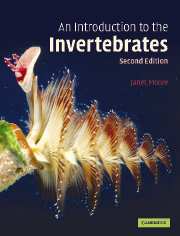Book contents
- Frontmatter
- Contents
- List of boxes
- Preface
- Acknowledgements
- Illustration acknowledgements
- Chapter 1 The process of evolution: natural selection
- Chapter 2 The pattern of evolution: methods of investigation
- Chapter 3 Porifera
- Chapter 4 Cnidaria
- Chapter 5 On being a worm
- Chapter 6 Platyhelminthes and Acoelomorpha
- Chapter 7 Nemertea
- Chapter 8 Nematoda
- Chapter 9 Annelida
- Chapter 10 Mollusca: general and Gastropoda
- Chapter 11 Mollusca: Bivalvia and Cephalopoda
- Chapter 12 Arthropoda: general
- Chapter 13 Crustacea
- Chapter 14 Chelicerata and Myriapoda
- Chapter 15 Insecta
- Chapter 16 Animals with lophophores
- Chapter 17 Echinodermata
- Chapter 18 Invertebrate Chordata and Hemichordata
- Chapter 19 Development
- Chapter 20 Invertebrate evolutionary history
- Further reading
- Glossary
- Index
Chapter 1 - The process of evolution: natural selection
Published online by Cambridge University Press: 05 September 2012
- Frontmatter
- Contents
- List of boxes
- Preface
- Acknowledgements
- Illustration acknowledgements
- Chapter 1 The process of evolution: natural selection
- Chapter 2 The pattern of evolution: methods of investigation
- Chapter 3 Porifera
- Chapter 4 Cnidaria
- Chapter 5 On being a worm
- Chapter 6 Platyhelminthes and Acoelomorpha
- Chapter 7 Nemertea
- Chapter 8 Nematoda
- Chapter 9 Annelida
- Chapter 10 Mollusca: general and Gastropoda
- Chapter 11 Mollusca: Bivalvia and Cephalopoda
- Chapter 12 Arthropoda: general
- Chapter 13 Crustacea
- Chapter 14 Chelicerata and Myriapoda
- Chapter 15 Insecta
- Chapter 16 Animals with lophophores
- Chapter 17 Echinodermata
- Chapter 18 Invertebrate Chordata and Hemichordata
- Chapter 19 Development
- Chapter 20 Invertebrate evolutionary history
- Further reading
- Glossary
- Index
Summary
This book is about invertebrate evolution. Every account of structure and function and the adaptation of an animal to its environment is a description of the results of evolution. Not only the intricate design but also the vast diversity of animals has been achieved by descent with modification due to the action of natural selection. A process so fundamental needs to be introduced at the very beginning of the book. As the different phyla are presented, general discussion of some other topics will become necessary (and will be inserted as ‘Boxes’), but evolution cannot wait.
What was Darwin's theory of natural selection?
Our understanding of evolution dates from the publication in 1859 of Charles Darwin's great book The Origin of Species by Means of Natural Selection, or the Preservation of Favoured Races in the Struggle for Life. Before that time, explanation of all the details of animal design in terms of a divine Creator was widely accepted, though perhaps the extraordinary variety of life (e.g. what has been termed ‘the Almighty's inordinate fondness for beetles’) was harder to explain. From very early times a few writers had postulated evolutionary theories, suggesting that different species might not all have been separately created, and further that complicated forms of life could have arisen from simple antecedents by descent with modification. This however was mere speculation in the absence of support from a large array of ordered facts.
- Type
- Chapter
- Information
- An Introduction to the Invertebrates , pp. 1 - 10Publisher: Cambridge University PressPrint publication year: 2006



